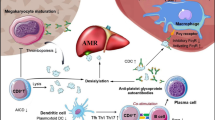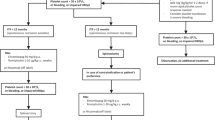Abstract
Immune thrombocytopenia (ITP) is an autoimmune disease primarily characterized by increased clearance of auto-antibody-sensitized platelets by Fc-receptor-bearing macrophages in the spleen and liver. It has been classically accepted that antibody-mediated platelet destruction is Fc dependent. Recent studies, however, may also indicate the involvement of Fc-independent pathways of platelet destruction. Current treatment options work by immunosuppression (e.g., corticosteroids), immunomodulation (e.g., IVIg and anti-D), or removal of the platelet destruction site (splenectomy) in ITP. This review will discuss the mechanisms of action of these and other treatments for ITP.
Similar content being viewed by others
References
Crow AR, Lazarus AH (2003) Role of Fcgamma receptors in the pathogenesis and treatment of idiopathic thrombocytopenic purpura. J Pediatr Hematol Oncol 25(Suppl 1):S14–S18
Jin F, Balthasar JP (2005) Mechanisms of intravenous immunoglobulin action in immune thrombocytopenic purpura. Hum Immunol 66(4):403–410
Kuter DJ, Gernsheimer TB (2009) Thrombopoietin and platelet production in chronic immune thrombocytopenia. Hematol Oncol Clin North Am 23(6):1193–1211
Rodeghiero F et al (2009) Standardization of terminology, definitions and outcome criteria in immune thrombocytopenic purpura of adults and children: report from an international working group. Blood 113(11):2386–2393
Provan D et al (2010) International consensus report on the investigation and management of primary immune thrombocytopenia. Blood 115(2):168–186. doi:10.1182/blood-06-225565
Olsson B et al (2003) T-cell-mediated cytotoxicity toward platelets in chronic idiopathic thrombocytopenic purpura. Nat Med 9(9):1123–1124
Zhang F et al (2006) Cell-mediated lysis of autologous platelets in chronic idiopathic thrombocytopenic purpura. Eur J Haematol 76(5):427–431
Zhang W et al (2009) Role of molecular mimicry of hepatitis C virus protein with platelet GPIIIa in hepatitis C-related immunologic thrombocytopenia. Blood 113(17):4086–4093
Webster ML et al (2006) Relative efficacy of intravenous immunoglobulin G in ameliorating thrombocytopenia induced by antiplatelet GPIIbIIIa versus GPIbalpha antibodies. Blood 108(3):943–946
Wright JF et al (1996) Characterization of platelet-reactive antibodies in children with varicella-associated acute immune thrombocytopenic purpura (ITP). Br J Haematol 95(1):145–152
Kuwana M et al (2002) Spleen is a primary site for activation of platelet-reactive T and B cells in patients with immune thrombocytopenic purpura. J Immunol 168(7):3675–3682
Crow AR, Lazarus AH (2008) The mechanisms of action of intravenous immunoglobulin and polyclonal anti-d immunoglobulin in the amelioration of immune thrombocytopenic purpura: what do we really know? Transfus Med Rev 22(2):103–116
Aslam R et al (2007) Platelet and red blood cell phagocytosis kinetics are differentially controlled by phosphatase activity within mononuclear cells. Transfusion 47(11):2161–2168
Chan H et al (2003) The IgG subclasses of platelet-associated autoantibodies directed against platelet glycoproteins IIb/IIIa in patients with idiopathic thrombocytopenic purpura. Br J Haematol 122(5):818–824
Go RS, Johnston KL, Bruden KC (2007) The association between platelet autoantibody specificity and response to intravenous immunoglobulin G in the treatment of patients with immune thrombocytopenia. Haematologica 92(2):283–284
Nieswandt B et al (2000) Identification of critical antigen-specific mechanisms in the development of immune thrombocytopenic purpura in mice. Blood 96(7):2520–2527
Nardi M et al (2004) Complement-independent Ab-induced peroxide lysis of platelets requires 12-lipoxygenase and a platelet NADPH oxidase pathway. J Clin Invest 113(7):973–980
Hed J (1998) Role of complement in immune or idiopathic thrombocytopenic purpura. Acta Paediatr Suppl 424:37–40
Cole TJ (2006) Glucocorticoid action and the development of selective glucocorticoid receptor ligands. Biotechnology Ann Rev 12:269–300
Fehr J, Hofmann V, Kappeler U (1982) Transient reversal of thrombocytopenia in idiopathic thrombocytopenic purpura by high-dose intravenous gamma globulin. N Engl J Med 306(21):1254–1258
Berchtold P et al (1989) Inhibition of autoantibody binding to platelet glycoprotein IIb/IIIa by anti-idiotypic antibodies in intravenous gammaglobulin. Blood 74(7):2414–2417
Hansen RJ, Balthasar JP (2002) Intravenous immunoglobulin mediates an increase in anti-platelet antibody clearance via the FcRn receptor. Thromb Haemost 88(6):898–899
Bayry J et al (2003) Inhibition of maturation and function of dendritic cells by intravenous immunoglobulin. Blood 101(2):758–765
Siragam V et al (2006) Intravenous immunoglobulin ameliorates ITP via activating Fc gamma receptors on dendritic cells. Nat Med 12(6):688–692
Anthony RM et al (2008) Identification of a receptor required for the anti-inflammatory activity of IVIG. Proc Natl Acad Sci U S A 105(50):19571–19578
Samuelsson A et al (2001) Anti-inflammatory activity of IVIG mediated through the inhibitory Fc receptor. Science 291(5503):484–486
Stasi R, Provan D (2004) Management of immune thrombocytopenic purpura in adults. Mayo Clin Proc 79(4):504–522
Newman GC et al (2001) A dose of 75 microg/kg/d of i.v. anti-D increases the platelet count more rapidly and for a longer period of time than 50 microg/kg/d in adults with immune thrombocytopenic purpura. Br J Haematol 112(4):1076–1078
Salama A et al (1984) Treatment of autoimmune thrombocytopenic purpura with rhesus antibodies (anti-Rh0(D)]. Blut 49(1):29–35
Ambriz-Fernandez R et al (2002) Fc receptor blockade in patients with refractory chronic immune thrombocytopenic purpura with anti-D IgG. Arch Med Res 33(6):536–540
Boughton BJ et al (1994) Autoimmune thrombocytopenia: anti-glycoprotein IIb/IIIa auto antibodies are reduced after human anti-D immunoglobulin treatment. Autoimmunity 18(2):141–144
Song S et al (2005) Monoclonal antibodies that mimic the action of anti-D in the amelioration of murine ITP act by a mechanism distinct from that of IVIg. Blood 105(4):1546–1548
Stasi R et al (2009) Effects of eradication of Helicobacter pylori infection in patients with immune thrombocytopenic purpura: a systematic review. Blood 113(6):1231–1240
Franchini M et al (2007) Effect of Helicobacter pylori eradication on platelet count in idiopathic thrombocytopenic purpura: a systematic review and meta-analysis. J Antimicrob Chemother 60(2):237–246
Asahi A et al (2008) Helicobacter pylori eradication shifts monocyte Fcgamma receptor balance toward inhibitory FcgammaRIIB in immune thrombocytopenic purpura patients. J Clin Invest 118(8):2939–2949
Stasi R et al (2007) Response to B-cell depleting therapy with rituximab reverts the abnormalities of T-cell subsets in patients with idiopathic thrombocytopenic purpura. Blood 110(8):2924–2930
Stasi R et al (2008) Analysis of regulatory T-cell changes in patients with idiopathic thrombocytopenic purpura receiving B cell-depleting therapy with rituximab. Blood 112(4):1147–1150
Erickson-Miller CL et al (2005) Discovery and characterization of a selective, nonpeptidyl thrombopoietin receptor agonist. Exp Hematol 33(1):85–93
Cohn CS, Bussel JB (2009) Romiplostim: a second-generation thrombopoietin agonist. Drugs Today (Barc) 45(3):175–188
Bussel JB et al (2007) Eltrombopag for the treatment of chronic idiopathic thrombocytopenic purpura. N Engl J Med 357(22):2237–2247
Kuter DJ et al (2008) Efficacy of romiplostim in patients with chronic immune thrombocytopenic purpura: a double-blind randomised controlled trial. Lancet 371(9610):395–403
Gernsheimer TB (2008) The pathophysiology of itp revisited: ineffective thrombopoiesis and the emerging role of thrombopoietin receptor agonists in the management of chronic immune thrombocytopenic purpura. Hematology Am Soc Hematol Educ Program 2008:219–226
Podolanczuk A et al (2009) Of mice and men: an open-label pilot study for treatment of immune thrombocytopenic purpura by an inhibitor of Syk. Blood 113(14):3154–3160
Author information
Authors and Affiliations
Corresponding author
Rights and permissions
About this article
Cite this article
Pang, S.J.Y., Lazarus, A.H. Mechanisms of platelet recovery in ITP associated with therapy. Ann Hematol 89 (Suppl 1), 31–35 (2010). https://doi.org/10.1007/s00277-010-0916-2
Received:
Accepted:
Published:
Issue Date:
DOI: https://doi.org/10.1007/s00277-010-0916-2




